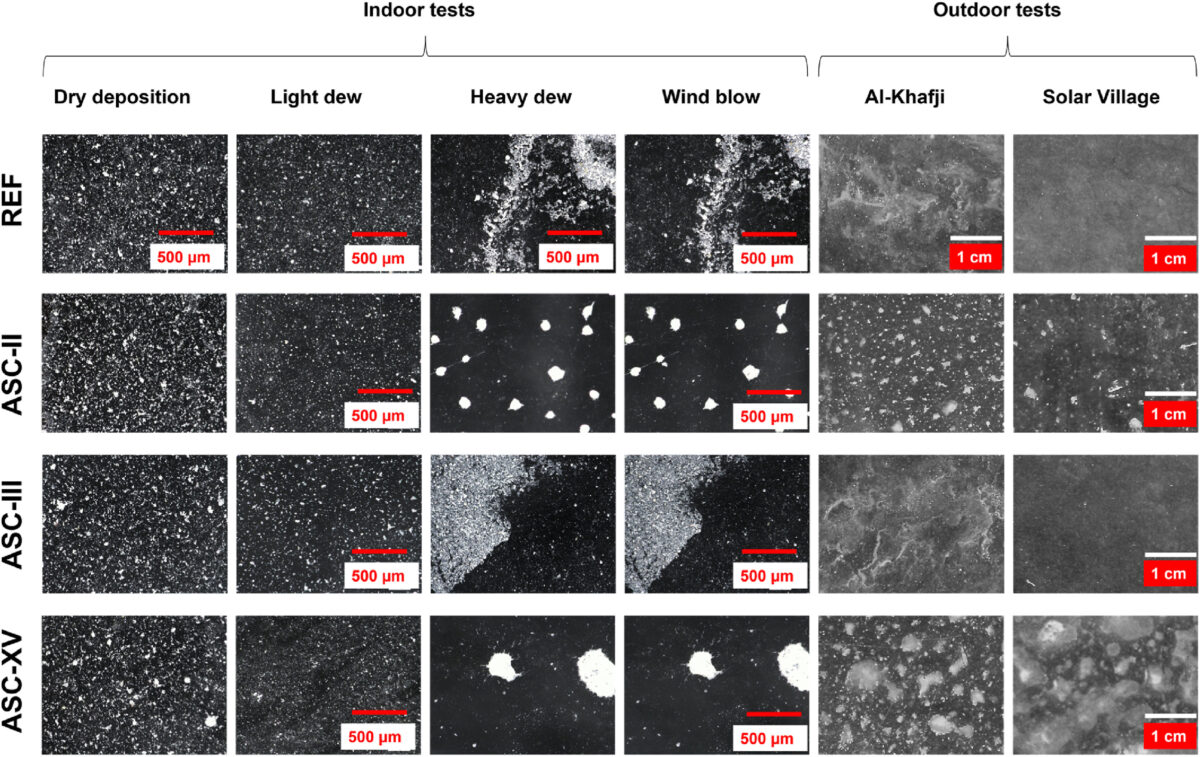A group of scientists have investigated the correlation between laboratory and outdoor soiling experiments for glass panels with anti-soiling coatings (ASCs). The outdoor experiments were conducted over a year in eight locations in Saudi Arabia and were compared to lab tests that replicated potentially relevant soiling mechanisms. “I am very optimistic that the results can be generalized to other arid and semi-arid areas with high soiling losses from mineral dust,” corresponding author Dr. Klemens Ilse told pv magazine.
“The laboratory tests consist of three main procedural steps: dry dust deposition, processes to modify dust adhesion, and a cleaning process, including characterization steps in between,” explained the researchers. “This study is the first to comprehensively analyze a large number of coatings and samples, correlate and compare the soiling patterns of the indoor and outdoor experiment results, and identify the key mechanisms for predicting the outdoor performance of ASC.”
The field tests took place from February 2019 to January 2020 in Al-Khafji, Solar Village, Al-Qassim, Riyadh, Makkah,Tabuk, Yanbu, and Al-Ahsa. In all locations, the glass samples were mounted at 25 degrees. Glass panels were changed and analyzed quarterly, except in Al-Khafji and Solar Village, where they were tested monthly. Different coatings were tested both in the lab and outdoors – some with hydrophilic properties, while some identified as hydrophobic.
In the lab test, all experiments were conducted at a sample tilt angle of 20 degrees, with Arizona A2 dust and wind speed of about 15 m/s when the wind was simulated. The scientists could control the humidity from 20% to 80% and the temperature from -5 C to 80 C. Four different tests were conducted to reflect different soiling mechanisms.
In dry deposition tests, which primarily reflect the process of particle rebound, dust was simply deposited on the samples. The dry deposition and wind blow tests, which represent the effect of particle resuspension, were done by deploying dust on the samples and then blowing on them with an air knife. Dew tests were done with either light or heavy dew, to simulate caking effects. In these test, dust was deposed, then wither light or heavy dew was simulated, followed by wind.
“In the annual average correlation analysis taking the annual average soiling losses into account, dry tests after wind blow and light dew tests after wind blow showed a strong correlation for most locations,” the scientists stated. “That is while dry tests after deposition and heavy dew tests after wind blow indicated a low correlation or anti-correlation respectively.”
Popular content

Image: Anhalt University of Applied Sciences, Solar Energy Materials and Solar Cells, CC BY 4.0 DEED
Explaining the results, the scientists said that in desert conditions, the increased particle resuspension by wind is one of the dominant factors for high anti-soiling performance. “The heavy dew tests in the laboratory may be more feasible for predicting soiling for locations with higher frequency of dew and especially strong dew events that can clean the surface, which are typically rare in the Middle East,” added Dr. Ilse.
The scientists also analyzed the Al-Khafji and Solar Village cases for seasonal footprint. The tests were conducted monthly and presented a general trend in which heavy dew tests appear to be more predictive of outdoor soiling behavior during the dry summer months, while the dry and light dew tests may be more predictive of soiling behavior in the humid winter months.
“These results may seem counter-intuitive at first, but they could be explained by the interaction of dew with hydrophobic and hydrophilic surface properties. This includes the processes of caking, increased particle captures during wet surface conditions, and reduced capillary adhesion during dry seasons,” the scientists said. “However, further investigations are necessary to gain a more comprehensive understanding of the observed effects, including outdoor and laboratory testing with various coating types.”
The results were presented in “Correlation between laboratory and outdoor soiling experiments with anti-soiling coatings,” published in Solar Energy Materials and Solar Cells. The research was conducted by academics from Germany’s Anhalt University of Applied Sciences, Fraunhofer Center for Silicon Photovoltaics (CSP), Fraunhofer Institute for Microstructure of Materials and Systems (IMWS) and Fraunhofer Institute for Silicate Research (ISC), as well as Saudi Arabia’s King Abdulaziz City for Science and Technology (KACST).
This content is protected by copyright and may not be reused. If you want to cooperate with us and would like to reuse some of our content, please contact: editors@pv-magazine.com.


2 comments
By submitting this form you agree to pv magazine using your data for the purposes of publishing your comment.
Your personal data will only be disclosed or otherwise transmitted to third parties for the purposes of spam filtering or if this is necessary for technical maintenance of the website. Any other transfer to third parties will not take place unless this is justified on the basis of applicable data protection regulations or if pv magazine is legally obliged to do so.
You may revoke this consent at any time with effect for the future, in which case your personal data will be deleted immediately. Otherwise, your data will be deleted if pv magazine has processed your request or the purpose of data storage is fulfilled.
Further information on data privacy can be found in our Data Protection Policy.